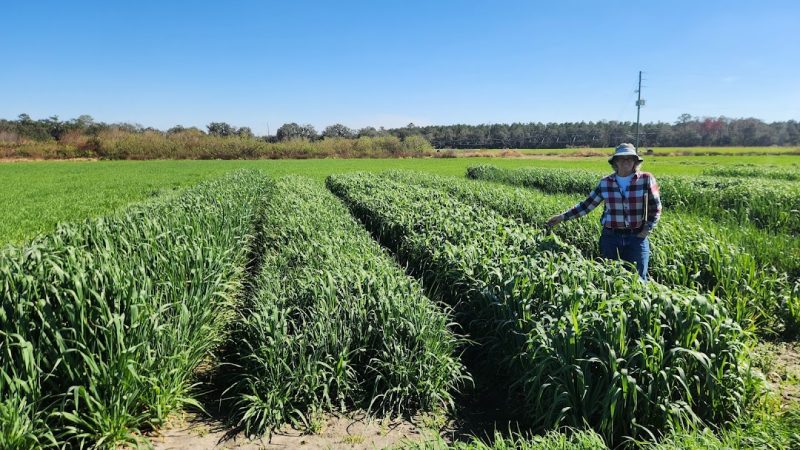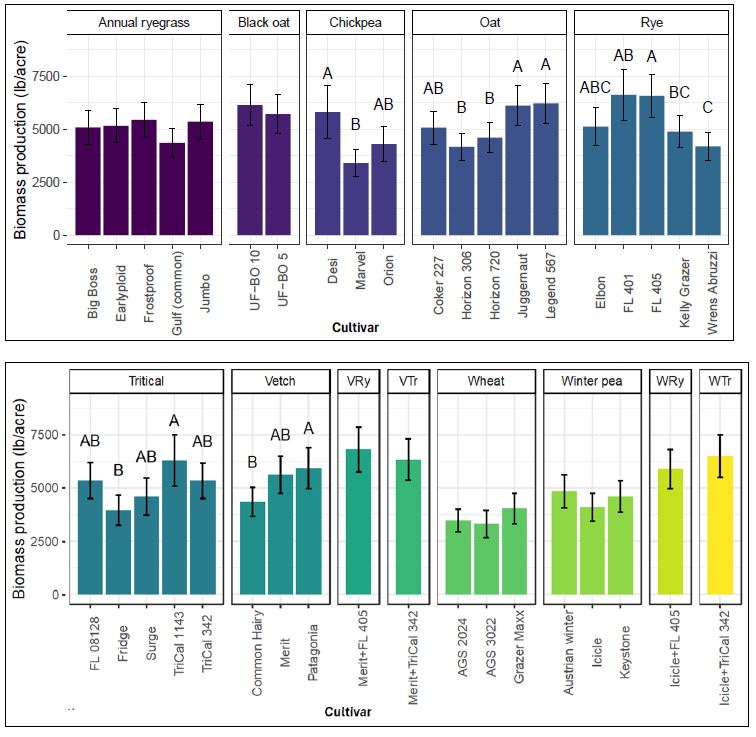Marcelo Wallau, Maria Elena Mailhos, UF/IFAS Agronomy Department Forage Team, Cheryl Mackowiak, UF/IFAS NFREC Soils Scientist, and Diwakar Vyas, UF/IFAS Animal Sciences Ruminant Nutritionist
It is about time to start thinking about cool-season forages. To help our farmers decide what to plant and our industry partners to put forward their best materials, the UF/IFAS Forage Team developed cool-season forage variety trials. In those trials, we evaluate commercial and experimental varieties of small grains (cereal rye, triticale, oat, and wheat) and annual ryegrass for productivity, quality, and disease resistance. These data help us create the variety recommendation lists, updated annually and based on three-year, multi-location performance (in collaboration with colleagues from the University of Georgia and Auburn University). The list of recommended varieties can be found at Cool-Season Forage Variety Recommendations for Florida. The data for the 2023-2024 cool-season forage trials is now available on our UF/IFAS Forage Team webpage.

Figure 1. Difference in performance of oat variety on dairy systems (lagoon irrigation). Legend 567 (left), Cocker 227 (center), and Juggernaut (right) oats, on January 30, 2024, 96 days after planting, with Dr. Cheryl Mackowiak.
–
Trial Details
This year, we tested 89 entries from 15 different companies and breeding programs. We conducted two separate trials: a traditional multi-cut trial for hay and grazing use, and a single-cut trial for silage production. Trials were on farm, with inclusion of a disease nursery and the traditional Southeast Dairy Producer sponsored demonstration sites called Milk Check-off.
- Multi-Cut Trial: Conducted at the Plant Sciences Research and Education Unit in Citra, FL. This trial followed a 4-week cutting interval. Plots were planted on October 27, 2023, with ryegrass at 30 lbs/A and small grains at 90 lbs/A. Fertilization included a split 30 + 50 lbs N/A of nitrogen before the first cut, followed by 50 lbs N/A after each subsequent cut. Harvests occurred on January 17, February 14, March 14, and April 10, 2024. No fungicides or insecticides were used.
- Single-Cut Trial: Conducted on-farm at White Oak in Lafayette County and UF Dairy in Alachua County, FL, this trial followed farm management schedules. Plots were planted on October 26, 2023, with ryegrass at 30 lbs/A and small grains at 90 lbs/A. All plots were harvested simultaneously on February 22, 2024, regardless of maturity. Target fertilization was between 120 – 150 lbs N/A.
- Disease Nursery: A separate disease nursery was planted at the PSREU, including all entries from both trials. No cuts were applied, and the main diseases observed were fungal leaf spots, rust, and viruses. Disease incidence was ranked on a 0-9 scale, then converted to percentage for the analysis. A high percentage indicates more susceptibility.
- Milk Check-off Demonstration Sites: In addition to the official trials, we implemented demonstration sites at four dairies in the region as part of the Milk Check-Off program: White Oak (Lafayette), Full Circle (Madison), Shenandoah (Suwanee) and UF Dairy (Alachua). We have been running those trials for multiple years, and every year we host a tour of those plots. Check out the following video update from the Milk Check-off demonstrations.
–
When interpreting the data, keep in mind that the Single-cut trial and the Milk Check-off demonstrations were grown with high nutrient levels (spray effluent) and irrigation, and harvested at early growth stages (boot stage to heading). This lead to somewhat different results compared to the Multi-Cut trial. For a grazing system, data rom the Multi-Cut trial is more representative, and the productivity at different harvest dates provides some indication of each cultivar’s maturity rate (early, mid or late maturing).

Figure 2. Results from the Milk Check-off on-farm cool-season forage demonstration trials 2022 and 2023 planting seasons (single cut, last week of February). Results are presented in lbs of dry matter per acre. VRy = vetch+rye mixture; VTr = vetch+triticale mixture; WRy = winterpea+rye mixture; WTr = Winterpea+triticale mixture. Vertical black bars represent standard errors and colored bars sharing the same letter within a given species are not significantly different at P = 0.05.
–

Table 1. Annual ryegrass production (lbs of dry matter/acre) over four repeated harvests in 2024. For data on multi-cut trial on oat, and single-cut trials on rye, triticale, oat, and ryegrass, check out the Forage Team website.
–
Updates on 2024 Cool-season Forages Recommendations
There are no major changes to the variety recommendations from recent years, although we have updates on disease resistance breakdowns that might affect the choice of cultivars and management practices. We have observed an increased crown rust in Legend 567 and Horizon 720 oats, two of our most popular and earliest oat varieties of oat that were previously listed as resistant. Breeders are in a constant race to release new oat varieties to keep up with rust infections that eventually take out older oat varieties. We still recommend using Horizon 720 and, especially Legend 567 because of its precocity (early maturity), but we advise scouting and potentially applying fungicides to prevent production and quality losses if harvesting for silage. In grazing systems, rust is less of a problem as old, infected tissue is removed through grazing. When cool-season forages are under stress, such as bouts of low or excessive soil moisture, or low soil fertility, they can often become more prone to various diseases Periodic scouting for signs of stress or diseases is frequently your best protection against stand losses.

Figure 3. Gray leaf spot on ryegrass (left), and crown rust on oat (center); and barley yellow dwarf virus (BYDV on oat (right).
–
Most of the leading seed distributors have reported good seed availability for fall, 2024, although newer varieties such as Trical 1143 and Trical Sprinter triticale might be limited. Make sure to order your seeds early and do not forget to check for seed quality (percent weed seed) and percent germination on the tagged bag. When planting cool-season annual legumes, consider inoculating or reinoculating just prior to planting, even if they are coated seed. Our research shows that there is better nodulation and potential nitrogen fixation when using fresh inoculants.
For more information, email the UF/IFAS Forage Team at forages@ifas.ufl.edu, or contact your local county extension agent.
- 2025 Southeastern Hay Contest Sets New Records - October 24, 2025
- 2025 Cool-Season Forage Official UF/IFAS Variety Trial Results - September 5, 2025
- Revisiting Crop–Livestock Integration in the Southeastern United States - September 5, 2025
